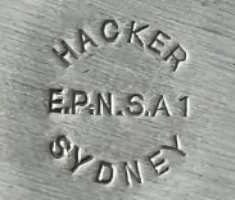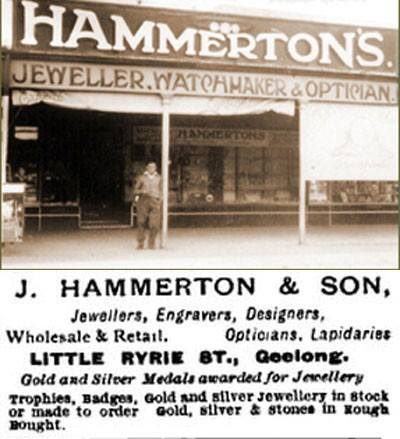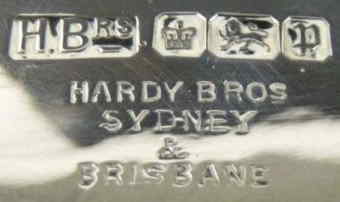THE DIRECTORY OF AUSTRALIA SILVERSMITHS
|
|
|
created by Giorgio B. owner of www.silvercollection.it ©  |
| This is a page of A Small Collection of Antique Silver and Objects of vertu, a 1500 pages richly illustrated website offering all you need to know about antique silver, sterling silver, silverplate, sheffield plate, electroplate silver, silverware, flatware, tea services and tea complements, marks and hallmarks, silver marking system and silver hallmarks guide, articles, books, auction catalogs, famous silversmiths (Tiffany, Gorham, Jensen, Elkington, WMF, Reed & Barton, Mappin & Webb, Bateman Family), history, oddities ... SITE MAP - HOME PAGE |
| AUSTRALIA SILVERSMITHS ALPHABETICAL LISTING - H - I - |
| AUSTRALIAN SILVERSMITHS
A
B
C
D
E
F
G
H
I
J
K
L
M
N
O
P
Q
R
S
T
U
V
W
X
Y
Z
NOT IDENTIFIED ALPHABETICAL LISTING OF MARKS |
(click on the photo to enlarge image)
| SILVERSMITH'S NAME AND MARKS |
SILVERSMITH'S INFORMATION |
HACKER'S SILVER PLATE MFG CO |
New South Wales, Sydney Active at 180 Commonwealth Street, later 27 Albion Street, Sunny Hills, Sydney. Manufacturer of a wide array of sterling silver and silverplate items. Trade mark SUPERIOR PLATE |
J.HAMMERTON & SON
 |
Victoria, Geelong active 1880s/1920s. Hammerton family is still in business but has changed location to Mildura, Victoria. Ryan Hammerton is the fourth generation silversmith in the family  |
HARDY Bros. Ltd.





 |
New South Wales, Sydney active since 1850s. They advertised as goldsmiths, silversmiths, manufaturers and also wholesalers but most of the holloware and flatware they sold wasn't actually manufactured by them. W.J. Sanders was the main supplier of the Hardy retail jewellery business in Australia. Hardy Bros had UK sponsor marks registered in London, Birminghham, Sheffield and Chester used to punch silverware manufactured by other British silversmiths. They were appointed with Royal Warrant as goldsmiths & jewellers on 22 July 1929. The conjoined HB was the mark used on items manufactured by the Sydney company Magnus Goldring (incorporating Edwin Harrop) and retailed by Hardy |
HARLEY Walter
 |
New South Wales, Sydney active 1820s |
HARRIS & SON |
Western Australia, Geralton manufacturer of a range of silverware featuring sterlinG silver Australia wildflowers |
| HARROP Edwin MAGNUS GOLDRING INC. EDWIN HARROP  |
New South Wales, Sydney Active in Sydney until his death (1894). The business, continued by his son Edwin George Harrop, was sold in 1915 to Magnus Goldring (representative of the firm since 1895). After his death (1918) his sons Harold and Leslie Goldring undertook the management of the family business that became a proprietary company in 1957. After the death of Leslie, the business was conducted by Harold Goldring and his two sons Magnus George and Kenneth. The present managing director of the company is Stephen Goldring (son of Magnus George and great grandson of the founder). Trade mark INVICTA |
HOLLINGDALE Edward Joseph |
born 1821 - died 1882 |
HENDRICK Charles (possibly) |
New South Wales, Sydney c. 1840 |
|
HALLMARKS OF ENGLISH SILVER -
MAKER'S MARK IDENTIFICATION
|
| IMAGES | A& AC |
AD AK |
AL AZ |
B& BB |
BC BO |
BP BZ |
C& CA |
CB CC |
CD CF |
CG CL |
CM CS |
CT CZ |
D& DB |
DC DL |
DM DZ |
E& EA |
EB ED |
EE EH |
EI EO |
EP EZ |
F& FD |
FE FJ |
FK FZ |
G& GB |
GC GG |
GH GL |
GM GR |
GS GZ |
| IMAGES | H& H& |
HA HB |
HC HE |
HF HL |
HM HU |
HV HZ |
I& IG |
IH IL |
IM IZ |
J& JA |
JB JC |
JD JG |
JH JK |
JL JQ |
JR JR |
JS JS |
JT JZ |
KA KZ |
L& LB |
LC LZ |
M& MB |
MC MI |
MJ MZ |
N& NZ |
OA OZ |
P& PK |
PL PZ |
QA QZ |
| IMAGES | R& RB |
RC RG |
RH RK |
RL RQ |
RR RZ |
S& SB |
SC SI |
SJ SR |
SS SZ |
T& TC |
TD TG |
TH TN |
TO TS |
TT TZ |
UA UZ |
V& VZ |
W& WA |
WB WB |
WC WC |
WD WE |
WF WG |
WH WL |
WM WM |
WN WR |
WS WS |
WT XZ |
YA YZ |
ZA ZZ |
|
BRITISH TOWN MARKS AND DATE LETTERS
|
AUSTRALIA AND ITS SILVER
A BRIEF HISTORY
|
|
